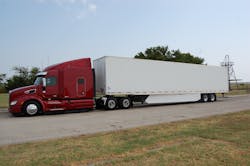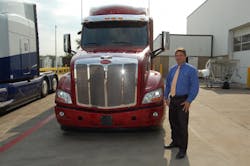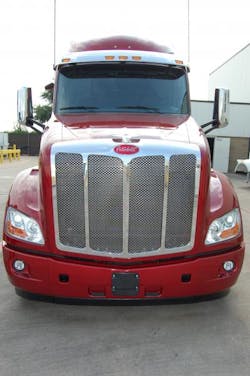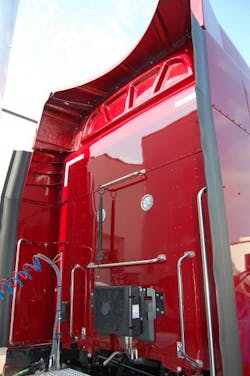DENTON, TX. Improving the aerodynamic performance of highway tractors often boils down to making small yet significant changes to its exterior shape – changes that can also be canceled out by aerodynamic enhancements to trailers, if one isn’t careful.
Those are just two of the lessons Peterbilt Motors Co. has gleaned not only from its involvement in the Dept. of Energy’s “Supertruck” program but also from the ongoing development work with its Model 579 EPIQ highway tractor spec, originally introduced back in 2014, explained Frank Schneck, the OEM’s division engineering manager.“For example, if you are pulling a trailer equipped with side fairings, then you want to equip the tractor with a front bumper air dam to redirect more air away from under the tractor to its sides, where it can also be further ‘smoothed out’ by the trailer side fairings,” Schneck (seen at right) told Fleet Owner.
“However, if the trailer does not have side fairings, you don’t want to push more air out to the sides – that will actually cause more turbulence and drag,” he stressed. “So when you don’t have trailer side fairings, you want more air to flow under the truck because that will actually create less drag compared to pushing out to the sides.”
Back when first rolled out in 2014, Peterbilt said its Model 579 EPIQ spec delivered a 10% increase in fuel economy compared to a “normal” Model 579, which jumped to 14% this year in part due to aerodynamic refinements and the combination with Peterbilt’s APEX powertrain package, which mates a Paccar MX-13 diesel engine to a 10-speed Fuller Advantage automated manual transmission (AMT).One example of aerodynamic “refinements” Peterbilt added to its Model 579 EPIQ spec are “recirculation shields” around the front of the motor inside the hood to redirect air not needed for engine cooling again out to the sides of the truck.
“In the past, we didn’t use recirculation shields on engines with under 450 hp but now we’re putting them in,” Schneck noted.
Interestingly, he pointed out that the wheel hub “close outs” added around the wheel fairing to close the gap between tire and wheel fender on the Model 579 EPIQ are actually designed to keep air from sliding out of the wheel well.
“We even added a wheel well liner to help channel that air through the well and out under the vehicle to keep the air along the side of the truck smooth,” Schneck said. “Keeping air smooth, thus eliminating turbulence, is what reduces drag.”
Another key factor learned over time is to keep the gap between tractor and trailer at 42 inches, he noted.
If the gap is too long, airflow over and around the tractor tends to “undershoot” the gap, falling into it and creating turbulence. But if the gap is too short, the airflow “overshoots” the gap and thus isn’t smoothed out properly, Schneck said.“That being, it’s better to ‘overshoot’ rather than ‘undershoot’ the gap, for ‘undershooting’ creates more drag,” he explained.
To help close an “ideal” 42-inch gap, Peterbilt developed 18-inch bolt-on sleeper berth extenders accentuated with an 8-inch rubber fairing “tip.” That total of 26-inches of gap coverage allows for several things to occur, Schneck noted: allowing airflow along the side of the truck to “jump” the tractor-trailer gap smoothly; provides enough swing room for the trailer when turning the vehicle; and blocking most crosswinds from entering the gap to generate turbulence.
Yet he pointed out that such external aerodynamic configurations are designed with 53-foot dry van trailers in mind. When flatbed trailers get involved, the aerodynamic picture changes drastically.
“For example, we designed the roof fairing close out panel and ‘bridge’ to help connect airflow smoothly from the top to the truck to the top of the trailer,” Schneck explained. “But when you move to a flatbed trailer, that ‘bigger square’ you’ve made with the roof fairing now actually creates more drag. So now you need to reduce the size of that frontal ‘square’ to reduce overall drag.”
It’s all part of the aerodynamic adjustments required for tractors based on their operational parameters and duty cycle, he said.
“It’s also why we continue to enhance our aerodynamic offerings, harvesting what we’ve learned from Supertruck as well as our ongoing on-road testing,” Schneck stressed.
About the Author
Sean Kilcarr
Editor in Chief
Sean Kilcarr is a former longtime FleetOwner senior editor who wrote for the publication from 2000 to 2018. He served as editor-in-chief from 2017 to 2018.



